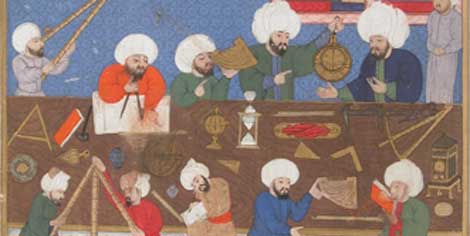BanÅ« MÅ«sÄ
The Banū - Mūsā brothers are three Muslim scholars who worked in Baghdad in the 9th century. They are known by reading books on geometry, astronomy and mechanical inventions ( machines). They are considered the founders of the Islamic mathematical tradition and as some of the earliest mathematicians who continued Greek mathematics.
Their names were Jafar Muhammad ibn Musa ibn Shakir (before 803 - January or February 873 ), Aḥmad ibn Musa ibn Shakir ( born and died in the 9th century ) and Al - Ḥasan ibn Musa ibn Shakir ( born and died in the 9th century ). Her scientific work are difficult to separate. The eldest of the three brothers Muhammad seems to have been the most important of the brothers. He worked as al -Hasan particularly geometry, but also in astronomy. Ahmad dealt primarily with mechanics.
Life
The name literally means Banū Musa sons of Moses. They were the sons of Musa ibn Shakir, an astrologer and astronomer who was a street robber in his youth, for the then governor of Khorasan and later caliphs in Baghdad al - Ma ʾ mun ( reigned 813-833 ) acted and with this was a friend. He lived in Merv and entrusted his three sons after his death, Al- Mamun at. Al- Mamun himself was very interested in science and had therefore established as a scholarly center of the House of Wisdom. After he recognized their scientific talent, let al - Mamun, the brothers in the House of Wisdom in Baghdad train. There acquired and translated them Greek manuscripts of philosophical and scientific content. Since they were very wealthy later, they used their own funds for the purchase of costly manuscripts and the translation work.
In the House of Wisdom and the mathematician al - Khwarizmi worked (known for its algebra), the Euclid - Hajjaj ibn Yusuf Al- translator and philosopher al -Kindi. The Banu Musa brothers were the leading scientist al - Khwarizmi and Hunayn ibn Ishaq worked with ( a leading translator of medical works ) and Thabit ibn Qurra (which she brought to the house of wisdom and Euclid and Apollonius of Perga translated ) together. Muhammad was a close friend of Hunayn. Also among the al - Mamun on the following caliphs Banu Musa brothers worked in the House of Wisdom. Under the ruling from 847 Caliph al - Mutawakkil there were arguments in the House of Wisdom, where the Banu Musa brothers against al -Kindi took sides. You erwirkten that this was the Caliph of favor.
Work
Their most famous work is the book of the measurement of plane and spherical figures ( Kitab al - Marifat masakhat Ashkal ), the results of Archimedes ( circle measurement, sphere and cylinder ), and these also evolved. Manuscripts of the book are in Oxford, Paris, Berlin, Istanbul and Rampur in India. It was translated by Gerard of Cremona in the 12th century into Latin as Verba filiorum ( Liber trium fratum de geometria ), of which manuscripts in Paris, Madrid, Basel, Toruń and Oxford are preserved. You used in the book which also used by Archimedes exhaustion of Eudoxus, for example, to specify a non- Archimedean method for circuit measurement, and interpreted geometric statements about areas and volumes as opposed to the Greek tradition ( the ratio of the areas and volumes of various body examined each other) with concrete numerical values. The book also contained the record of the Heron, which she attributed to Archimedes and a method for trisection of an angle, where they use a kinematic method.
As astronomers they made, for example, width provisions on behalf of the Caliph, length rules from the observation of lunar eclipses at the same time in Baghdad and Samarra and determined the length of the year. From Muhammad produced several books on astronomy, including over the movement of the celestial spheres, in which he criticizes Claudius Ptolemy.
My Book of Inventions ( Kitab al - Hiyal ) of 850 led about one hundred devices with illustrations, including many machines. Some of them were inspired by Heron of Alexandria and Philo of Byzantium, but also of Persian, Indian and Chinese sources and the book contained many of their own inventions in particular to control of machines. It comes from Ahmad and manuscripts are in Berlin and the Vatican.
They wrote almost twenty books, most (up to three), however, are lost. Among them was a commentary on the conics of Apollonius and a book on music theory.
Writings
- Donald Routledge Hill ( translator ): Banu Musa: The book of ingenious devices ( Kitāb al - ḥiyal ), Dordrecht, Reidel, 1979 Arabic edition published by Ahmad Y. al -Hassan, Aleppo, Institute for the History of Arabic Science 1981
- The Arabic edition was published in 1940 in Hyderabad: Rasa ʾ il al - Tusi









